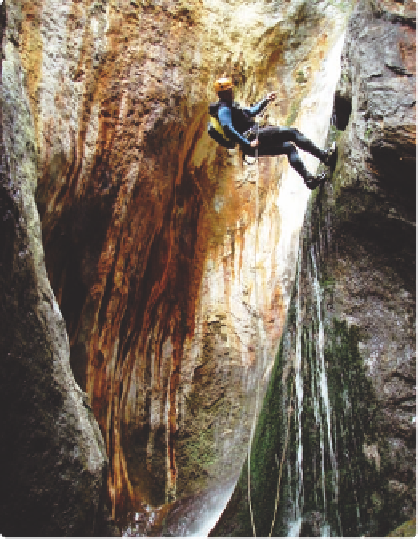Travel Reference
In-Depth Information
079 bathe in a natural spa
On both sides of the Pyrenees, but especially
in France, there are thermal spas where you
can bathe in natural minerals and sulphurous
water (the French have been doing so since the
Roman times) - ideal after a day in the great
outdoors. One of the largest geothermal spas is
150m underground at Bagnères-de-Luchon in
the central Pyrenees (a 2hr train journey from
Toulouse). There are several B&Bs and hotels
along the town's main high street, but for a more
homely break, stay 3km out of town in the small
village of Juzet-de-Luchon at Le Poujastou,
a converted eighteenth-century inn with five
rooms where you'll dine on home-made stews.
Other natural spa towns include Barèges in the
west, Argelès-Gazost and Ax-les-Thermes in
the central French Pyrenees, as well as Caldes
de Boi in the Catalan region of the Spanish
Pyrenees.
dark place”). If you
catch your breath,
you can peer
into ancient cave
dwellings, spot a
variety of birds and
enjoy spectacular
water pools.
Need to know
Rafting season
is from April to
September. For
details of where
to go canyoning
in the Sierra de
Guara see
W
www.
caiaragon.com. For
canyoning in France
(near Bar
è
ges in the
western Pyrenees) see
W
www.mountainbug.com;
T
+33 (0) 562 921 639.
Canyoning in the Sierra de
Guara
Need to know
For opening times, programmes
and reservations for Luchon's spa see
W
www.
thermes-luchon.fr;
T
+33 (0) 561 945 252. Le
Poujastou:
W
lepoujastou.com;
T
+33 (0) 561 943
288.
081 take the train to the mountains
Trains run at least into the foothills of the
Pyrenees, after which you'll need buses to get
higher. Access from the French side is from
three main train stations: Pau, in the west,
for Lourdes and the Pyrenees National Park;
Toulouse in the centre, for Luchon, Foix and
Andorra; and Perpignan, in the east, for the
Mediterranean coast. On the Spanish side, there
are few trains that run into the central Pyrenees
- rail services mainly head into the mountains
from the towns of the Atlantic (such as San
Sebastián) and Mediterranean coasts (Barcelona
and Girona).
080 canyoning in the Sierra de
Guara
Canyoning is one of the fastest-growing sports
in the Pyrenees. It's a heady combination of
scrambling, climbing, jumping off rocks in
sculpted gorges then floating and swimming
down ravines - and there are few better places
in Europe to do it than the Parque de la Sierra
y los Canones de Guara near Huesca. In this
protected area the four main rivers (the Flumen,
the Guatizalema, the Alcanadre and the Vero)
have carved out a range of geological formations
including caves, pits and spectacular canyons
through the mountains.
One of the most popular stretches is the River
Vero canyon, which is 8km long and has a drop
of 250m (it takes 4.5-6hr to complete). En route
you pass high cliffs, wall paintings and an
underground passage known as Los Oscuros (“the
Need to know
For train timetables and
reservations in the French Pyrenees see
W
www.
sncf.fr; for the Spanish Pyrenees see
W
www.renfe.
es. All Pyrenean towns have a single main bus
station, though services are drastically reduced
on Sundays; local tourist offices will also have
timetables. Accommodation options, hiking trails
and general information on the French Pyrenees
are at
W
www.lespyrenees.net.



















Search WWH ::

Custom Search